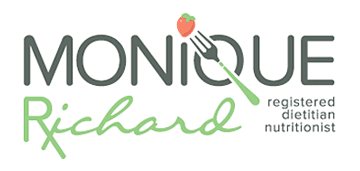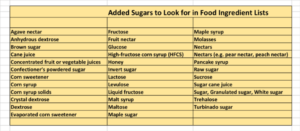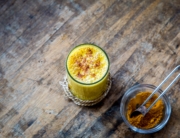Sugar. How sweet it is. Is it a villain, ‘the’ enemy, the end of health as we know it? Nah. Are manufacturers and food scientists using it to lure consumers with its pleasurable qualities? Absolutely. Is it being consumed in larger amounts than recommended by the vast majority of Americans? Yes.
It’s a pretty well-known fact that sugar is in cookies, cake, pie, candy and ice cream but sugar can be lurking in just about any food or drink, especially true for those in a package, wrapper, bottle or carton. Sugar can be hiding in some unexpected places such as breakfast cereals, bread, yogurt, and condiments to name a few.
Sugar by any other name is, guess what? Still sugar. Created equal? Not always. Similar effect in the body? Yes. Is the sugar in fruit-fructose- better for you? Not always, depends on amount and many other factors. To add to the confusion, companies may list sugar in the ingredients by one of the many other names it can go by. Figuring out where, how much and what is in an item can be a bit of sugar ‘hide and seek.’
The body needs sugar, specifically glucose for energy. We are mostly concerned with added sugar—the white sugar/honey/syrups (see list of other names) that is added –in addition to– what the item already has in it or is made of (for example caramel drizzle to the apple that naturally has fructose and glucose in it- two sugars PLUS the caramel drizzle sugar).
The 2015-2020 Dietary Guidelines for Americans recommends no more than 10% of your total daily calorie needs should be from added sugar. Therefore, if following a 2,000-daily calorie eating pattern, roughly 200 calories can be allotted for added sugar. It does not take long to max out that recommendation. For example, a teaspoon of white table sugar has approximately 16 calories and a regular soft drink has roughly 9 teaspoons of sugar which is 140 calories. In one 12-ounce beverage ¾ of the daily recommended allotment is met, if 2000 calories is necessary for your individual needs.
Unaware of where this sugar is hiding to begin to track it? Let’s break down further where to look, what to look for and the different names sugar can have and foods sugar may be hiding in.
First, scan the Nutrition Facts Label, which has undergone some changes making ‘sugar hide and seek,’ a little more difficult for manufacturers. An advantage to consumers. On the new label, underneath “Total Sugars” the sub-category of “Added Sugar” appears. The grams of sugar that does not occur naturally in that food will be listed here, what is in addition to that food item.
Second, look for added sugar in the ingredients list. Names to look for other than sugar are: any syrups (ex. high fructose corn syrup, sorghum, maple or malt), ingredients ending in “ose” (dextrose, fructose, sucrose), fruit juice, molasses, honey, or agave. Sugar alcohols (slightly different absorption and carbohydrate composition) usually have ingredients ending in “ol.” A more expansive list of other names for sugar is featured below for your reference.
Too much of anything can have consequences, especially something like sugar that offers energy (calories) but not a lot of nutrients (no fiber, C, E, potassium, calcium, etc. in sugar). Hence the term ‘empty calories.’ When we take in more ‘empty calories’ than nutrient-dense or nutrient-rich foods to meet our needs the risk for diabetes, heart disease, obesity, elevated lipids, dental caries (cavities) and some cancers could be increased.
Sugar alone is not public enemy number one, but it does need to be on the radar and monitored regularly. Know where it is hiding and what you are seeking. Knowledge is power and when it comes to your body, knowledge about the food we consume empowers you to have a healthier future. Why not start today, I am here to help!











